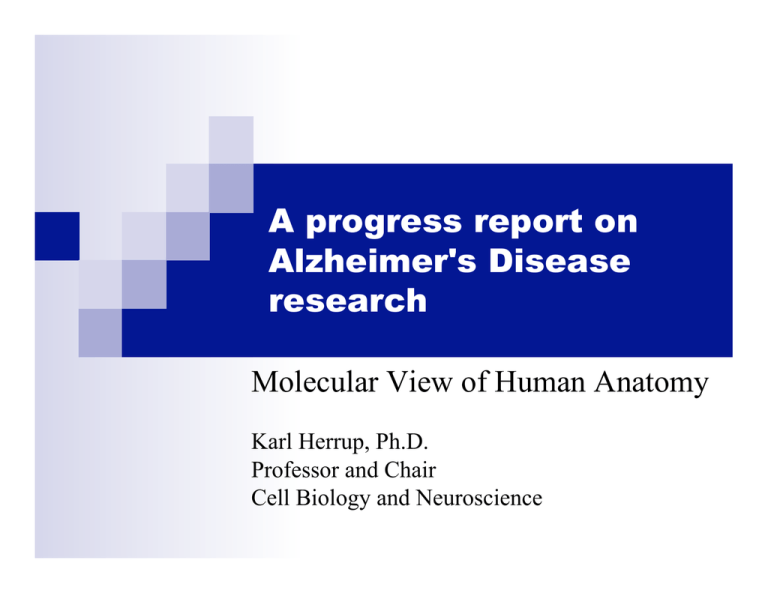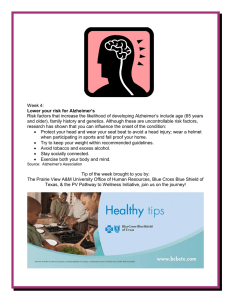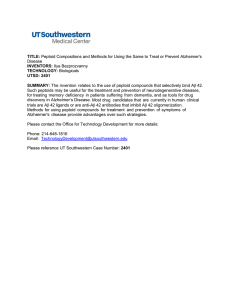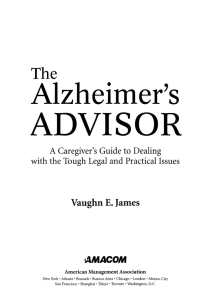A progress report on Alzheimer's Disease research
advertisement

A progress report on Alzheimer's Disease research Molecular View of Human Anatomy Karl Herrup, Ph.D. Professor and Chair Cell Biology and Neuroscience Alzheimer's disease The bad news Common Devastating to individual and their caregivers Progressive Currently no cure The good news A triumph of modern medicine Diagnosis has improved Research is pointing towards future prevention Alzheimer’s disease The most common cause of late life dementia. 4.5 million people now at some stage of AD 350,000 patients and caregivers affected in NJ alone After age 65, the percentage of AD doubles every 5 yrs. By 2050, 13.2 million older Americans are expected to have AD. The national cost of caring for people with AD is about $100 billion every year. Alzheimer’s disease Memory Language Spatial perceptions Executive functions Judgment Problem solving Behavior Attention Depression Aggression Apathy Alzheimer’s disease How does Alzheimer's start? Mild cognitive impairment (MCI) Detectable clinical impairment No reduction in activities of daily living 70% of MCI 'converts' to AD Some to other dementia Some 'resolve' Alzheimer’s disease Alois Alzheimer, 1906 Plaques Tangles Synaptic density loss Cell loss Hippocampus Basal nucleus Locus coeruleus Dorsal raphe Alzheimer’s disease Regional variations Alzheimer’s disease Neuropathology hippocampus basal nucleus Emotional control dorsal raphe locus coeruleus Alzheimer’s disease Emotional control Alzheimer’s disease Preclinical Mild AD Severe AD Alzheimer’s disease Early onset (<10%) Before age 65 Nearly always familial 3 major genes Amyloid precursor protein (APP): ~1% Presenilin-1 & 2 (PSEN1/2): ~8% Late onset (>90%) Sporadic Some risk factor genes ApoE, IDE, others Alzheimer’s disease APP at the heart of the disease APP sticks through the neuron membrane. Enzymes cut the APP into fragments of protein, including β-amyloid. Beta-amyloid fragments come together in clumps to form plaques. 1. 2. 3. Alzheimer’s disease γ-secretase (PSEN is active part) β-secretase Alzheimer’s disease - tau The role of tau No genetic implication No clear link to Aß Frontotemporal dementia FTDP-17 Other genes The importance of splicing Alzheimer’s disease - tau Alzheimer’s disease Factors that cut your risk NSAIDS indomethacin, ibuprofen, naproxin Not aspirin or acetominophen Statins Estrogens Anti-oxidants – vitamin E Life style choices ‘Origins’: early cognitive performance NOT aluminum pots and pans Progress: first steps Basal nucleus Projects to hippocampus >75% lost in AD Cells use acetylcholine Cholinesterase inhibitors Symptomatic relief Progress: first steps Aricept, Reminyl, Cognex, Tacrine Acetyl cholinesterase inhibitors block the breakdown of acetyl choline Progress: first steps Aricept, Reminyl, Cognex, Tacrine Acetyl cholinesterase inhibitors block the breakdown of acetyl choline Memantine/Namenda NMDA inhibitors block receptors for glutamate Progress: next steps The amyloid hypothesis The disease starts with incorrect cutting of the APP protein ß-amyloid is made ß-amyloid aggregates into plaques ß-amyloid and plaques are bad for neurons and kill them Progress: next steps Animal models - plaques but no tangles or cell loss Progress: next steps A vaccine for Alzheimer’s? Progress: next steps Untreated Vaccinated with Aβ Plaques can be prevented or cleared Cognition improved Can be active or passive immunization Works in primates Progress: next steps Clinical trial 1 30 patients Test for safety Clinical trial 2 >300 patients at several sites Changed the adjuvant Test for efficacy Trial halted due to 'adverse events’ Progress: next steps Clinical trials redux All subjects continue to be followed Four individuals died (of unrelated causes) At autopsy plaque density was lower than expected Imaging Some made antibody (responders); some did not Brain size reduced by ~3% in ‘responders’ Cognitive decline was less in ApoE4 carriers What have we learned An outstanding clinical trial: good design/all the data Facts are facts - we can clear the plaques We think we know how to manage the adverse events Progress: next steps Adult neurons never divide normally Forcing them to divide kills them Neurons in AD brain are 'trying' to divide AD hippocampal pyramidal cells Progress: next steps We have strong evidence of how neurons die Divide and die - in mouse and man Gives us a marker -- mouse cells divide too NSAIDS block the cycle Morphology Mac1 CD45 Inflammatory markers Amyloid Deposition Neuronal Cell Cycle Progression Birth 3 6 Ibuprofen in chow 9 12 15 18 21 Progress: next steps Other evidence based approaches Life style changes Beta-secretase inhibitors Gamma-secretase inhibitors Other plaque busters Tau aggregation inhibitors Early diagnosis (imaging) and intervention Others Mental and physical exercise (maintain your brain) The future looks promising




